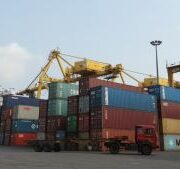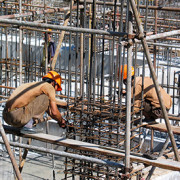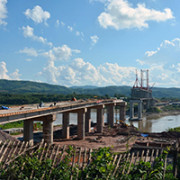Finance sector development
 Industry and trade, Regional cooperation and integration
Industry and trade, Regional cooperation and integration
 Energy
Energy
 Economics
Economics
 Governance and public sector management
Governance and public sector management
 Finance sector development
Finance sector development
 Health
Health
 Economics
Economics
 Infrastructure, Regional cooperation and integration
Infrastructure, Regional cooperation and integration
 Economics, Finance sector development
Economics, Finance sector development

Measuring the systemic risk contribution of international mutual funds

During the global financial crisis of 2007–2009, the importance of the scale and correlation of entities in interconnected financial systems, especially on what have become known as “too big to fail” institutions in the global financial system, was clearly evident and spotlighted.
RCEP – a life raft for trade liberalization in Asia

There seems to be a pushback against trade agreements in the post global financial crisis era. The Trans-Pacific Partnership (TPP) was signed in early 2016, but US presidential candidates have spared no effort criticizing it so near-term ratification is highly uncertain. The WTO Doha Round is in the deep freeze after 14 years of negotiations. Unilateral trade liberalization has virtually come to a standstill.
India: The rising star on the world’s energy horizon

Access to energy sources at low prices will continue to drive the world’s political agenda as energy is a component as well as an object of national power. The world’s primary energy consumption from commercial sources of energy has grown from approximately 8,600 million tons oil equivalent (mtoe) to 13,000 mtoe from 1995 to 2015 and is forecasted to grow approximately by the same amount to 17,300 mtoe by 2035.
Impact of a possible growth slowdown of the People’s Republic of China on emerging Asia: A general equilibrium analysis

With its rapid economic growth and integration into the global economy over the last 3 decades, the People’s Republic of China (PRC) has emerged as a major economic power and an important source of growth for the world economy. Now it is the second-largest economy at market exchange rates and the largest exporter in the world. In Asia, the PRC’s role as a growth pole is even more prominent. Over the last 10 years, spurred by strong processing exports and domestic demand, the PRC’s imports from Asia in US dollar terms have increased at an average annual rate of 9%. Strong demand from the PRC also supported prices of commodities exported by Asian and other emerging economies.
E-government as a vehicle to reduce white-collar crimes

The increasing use of the internet in recent years has caught the fancy of consumers and producers, in commodities, services, and leisure activities. The wide prevalence of wireless internet access and the portability of devices such as smartphones and tablets have increased access and diffusion of related services and products as possibly no other technology in history.
Spillover effects of unconventional monetary policy on Asia and the Pacific

On August 2015, the People’s Bank of China devalued the yuan with the aim of appreciating the currency against the US dollar. On October 2015, the European Central Bank signaled the intention to pump more liquidity into the eurozone economy. On October 2015, the Federal Reserve postponed its intention to conduct tapering on its monetary policy. Over the last 24 months, the dollar has been up nearly 10% against a major currency index of its trading partners. Emerging market economies have been facing disappointing growth, more volatile foreign exchange rates, and low inflation due to the slowdown in economic activities and the sharp decline in commodity prices. Moreover, the growth of debt in emerging countries has increased dramatically compared to advanced economies. Since 2009, the average level of private credit as a proportion of gross domestic product (GDP) has increased from around 75% to 125%. These stylized facts highlight deep uncertainties and downside risks in Asia. Measures of regional financial integration, capital market deepening, and emerging market banking systems must be carefully evaluated.
Rapid growth of overweight and obesity in Indonesia: Increasing risk for the poor

New ADBI research (Aizawa and Helble, forthcoming) studies how overweight and obesity have become major threats to public health in Indonesia. The evidence shows that obesity, which was previously a problem among high-income groups in the country, has spread across all income groups. Obesity in the lower-income groups, in particular, has been rising rapidly. Overweight and obesity significantly increase the risk of suffering from a large number of chronic conditions. Lower income groups are particularly ill-prepared to face continuously high health expenditures, as health systems remain weak. Urgent policy action is needed to mitigate the risk of these groups of falling into poverty due to high health expenditures caused by diseases related to obesity.
Kuroda should rethink the quest for 2 percent inflation

The Bank of Japan had a difficult start into 2016. The latest data shows that inflation in the last quarter of 2015 was lower than expected. Furthermore, doubts are increasing about the recovery of the economy. At the end of January, BOJ Gov. Haruhiko Kuroda surprised markets by announcing negative interest rates for certain commercial bank deposits at the BOJ. On March 1 Japan started to sell government bonds with a yield below zero. Market observers expect even bolder steps later this year.
Boosting South Asia integration through the realization of dream projects

Despite strong linkages in the past during the colonial period and strong ethnic and traditional ties, South Asian countries have become increasingly more diverse since their independence. While they are geographically closely connected, this does not mean that they are well integrated. Countries in the region have vastly different sizes, populations, and topography, and there are significant differences in their economies and income per capita. The conditions, however, might be ripe for a boost in regional integration. Implementing highly visible and symbolic transport connectivity projects, which have long been considered as dream realizations, would trigger the acceleration of regional integration for the benefit of all.
Budgeting data gaps and fiscal policy debate

Singapore has regularly reported considerable surpluses in its annual fiscal budget. Budget surpluses have been an essential part of the country’s growth strategy (Asher et al. 2015) as they are perceived to provide a signal of sound public sector financial management to foreign investors, key stakeholders in Singapore’s development planning. Budget surpluses also enable the corporate income tax rate to be kept among the lowest in the world, at 17%. Other policies—such as having a relatively large inflow of foreign workers that depresses at the lower end and almost no taxes on most forms of capital gains and domestic interest income—contribute to the high share of capital income in national income at around 55%, with labor’s share at around 40%–42%, in contrast to the pattern in OECD countries.


Search
Subscribe / Connect to Asia Pathways
Subjects
- Accelerating Progress in Gender Equality
- Addressing Remaining Poverty and Reducing Inequality
- Agriculture and natural resources
- Capacity development
- Climate change
- Economics
- Education
- Energy
- Environment
- Finance sector development
- Gender
- Governance and public sector management
- Health
- Industry and trade
- Information and Communications Technology
- Infrastructure
- Making Cities More Livable
- Miscellaneous
- Population
- Poverty
- Private sector development
- Regional cooperation and integration
- Sanitation
- Social development and protection
- Strengthening Governance and Institutional Capacity
- Subjects
- Transport
- Uncategorized
- Urban development
- Video Blog
- Water
Recent Posts
- Investing in Childcare a Win for Women and the Economy
- Flush and Flourish: Upgraded Toilets Can Transform Lives in Rural Asia
- New Ways for Climate Finance and Development in Asia and the Pacific
- Rethinking High-Rise Living: Balancing Urban Growth and Sustainability in Asia’s Cities
- Navigating Linear Transport Infrastructure Through Conservation Landscapes




Recent Comments